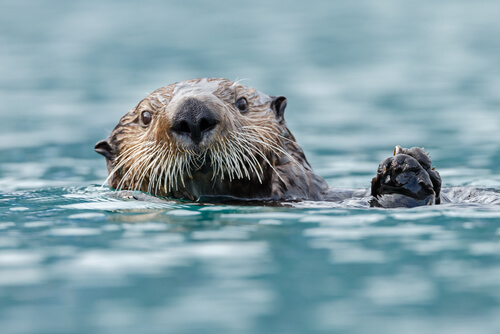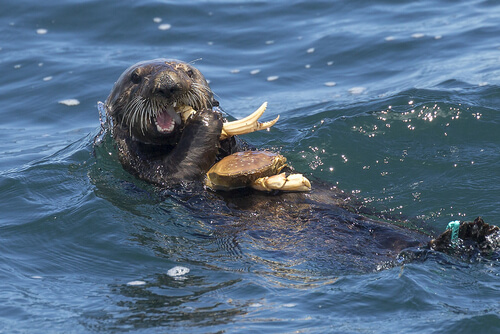
| Kingdom | Animalia |
| Phylum | Chordata |
| Class | Mammalia |
| Order | Carnivora |
| Family | Mustelidae |
| Genus | Enhydra |
| Species | Enhydra lutris |
| Niche | Keystone Marine Predator |
| Length | 4-5 ft (1.2-1.5 m) |
| Weight | 25-99 lb (14-45 kg) |
| Lifespan | 10-20 years |
| Social Structure | Same-sex groups (rafts) up to 100 individuals |
| Conservation Status | Endangered |
| Preferred Habitat | Coastal and offshore marine habitats |
| Average Litter Size | 1 |
| Main Prey Species | Sea urchins |
| Predators | Sharks, orca, eagles, bears |
The Basics
The sea otter is a well-known marine mammal with a historical range along the west coast of North America. Hunted nearly to extinction by the fur trade, sea otters are endangered and currently exist in only a portion of their historic range. Sea otters are the smallest marine mammal species.
Description
Sea otters are a medium-sized member of the Mustelidae family. The largest of this weasel family, sea otters weigh 31-100 lb (14-45 kg). Their fur is brown with shades of lighter tan and yellow on the heads of adults. They have long whiskers, small ear flaps, and two small black eyes. It has many special adaptations that help it to thrive in its marine environment, including nostrils that it can close when diving for food and long, broad, webbed hind feet that help them to be such proficient swimmers. They have short, clawed front paws with pads on their palms that aid in gripping their often slippery prey. Finally, much like humans and many other mammals, otters have sharp, pointed front teeth that aid in slicing and tearing their food as well as several flat, round molars used for crushing and grinding their food.

Distribution and Range
Historically, sea otters were ubiquitous along the west coast of North America from Alaska to Mexico. The arch of their historic range even stretches across the North Pacific to Russia and Japan. However, sea otters were driven near extinction by the fur trade that began in the 1740s and only exist in parts of their historic range, despite an ongoing comeback.
Within this range, most sea otters live in coastal waters, although some live offshore as well. In general, they prefer relatively sheltered areas that will provide some protection from the most extreme ocean winds. Otters are able to walk on land if required but are capable of spending their entire lives in the water, making them the only members of the weasel family able to do so.
Diet and Predators
Sea urchins are carnivorous predators, eating mostly sea urchins. They are diurnal, preferring to forage in the early morning and the late afternoon while resting through much of the night and the middle of the day. They will also be active in darkness, often foraging around midnight as well.
Sea otters can dive to impressive depths of up to 30 m (100 ft) or more to forage on the seafloor. Besides their preference for sea urchins, of which they eat so many it will often stain their teeth purple, sea otters will also eat other invertebrates such as various mollusks, crustaceans, and even some fish.

Common predators of sea otters include various predatory marine mammals such as orcas and sea lions. Eagles may also grab young otters if given the opportunity. While on land, pups may also face threats from predators such as bears and coyotes. Interestingly, there is no evidence that great white sharks eat otters despite overlapping in parts of their range.
Reproduction
Sea otters are a polygynous species, in that males have multiple partners. Births occur year-round, and females are capable of delayed implantation, waiting to allow their mate’s sperm to fertilize their eggs, perhaps in response to seasons and the availability of alternative mates.
Following copulation and a gestation period of about six months, females typically give birth to just one pup. This pup will stay near to its mother, often riding on her back to catch an easy ride. At about 2 months of age, the pup will begin to dive for food on its own. However, females will continue to nurse and care for pups for about 6 months before weaning them entirely. Sea otters become sexually mature at 3-5 years of age, with males maturing 1-2 years slower than females.
Conservation
Sea otter numbers were once up to 300,000 individuals along the west coast of North America. However, during the colonial era, from 1741 to 1911, they were hunted extensively, mostly for their pelt, and their numbers were reduced to as few as 1,000 individuals in just a small fraction of their historic range. Ultimately, they protected and numbers have rebounded since, thanks to this protection and efforts to reintroduce them to regions where they were formerly hunted to extinction. Currently, sea otters can be found in approximately two-thirds of their historic range, although they remain an endangered species
Fun Facts about Sea Otter!
Nowadays, sea otters are beloved due to their appearance and charismatic personalities. However, it is only once they were hunted nearly to extinction that we came to realize their value alive as a keystone species rather than a fur pelt.
What Thick Fur You Have
Sea otters have incredibly dense fur, with up to 150,000 hair follicles per square centimeter. This is largely what made their pelts so popular in the fur trade when colonists and settlers arrived in North America. In thanks to this thick coat – which consists of long, waterproof guard hairs over their shorter underfur that keeps water completely away from their skin – they are the only marine mammal to keep warm using fur rather than a fat layer for insulation. Indeed, their fur is the densest in all of the animal kingdom.
Regulators
In areas where otters are absent, sea urchins have overtaken the kelp on which they feed, laying waste to hectares of kelp forests that provide essential habitat for many species, including a nursery for common commercially fished species. When sea otters are present, as they were before being hunted to the brink of extinction by humans, they feed on the sea urchins, keeping their populations in check. In doing so, sea otters maintain the kelp forests, making them a keystone species in this habitat.

Tool Time
Sea otters are intelligent and proficient foragers and hunters. They will use rocks as tools to dislodge mollusks from the substrate onto which their powerful foot can hold on very tightly. This puts the sea otter in a small group of mammals such as chimpanzees that use tools.
